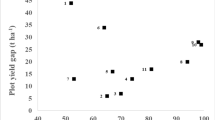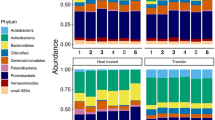Abstract
Concentrations of DNA of the potato pathogens Rhizoctonia solani, Spongospora subterranea and Streptomyces scabies in surface soil (0–150 mm depth) from potato farm paddocks were monitored annually for 8 years in South Australia and Tasmania. A non-linear model was fitted to these data to test if changes in DNA concentrations could be explained by changes in land use in the paddocks, and so identify land uses with potential to either increase or decrease the risk of disease caused by these pathogens. Spongospora subterranea and R. solani anastomosis group (AG) 2.1 were the most prevalent pathogens in both states, followed by St. scabies and R. solani AG3, and R. solani AG4 in Tasmania. The fitted model showed prior crops of poppy and potato to be associated with increased R. solani AG2.1 DNA concentrations; and prior crops of carrot, fallow, poppy and ryegrass with increased R. solani AG3 DNA concentrations, while a prior potato crop was associated with increased concentrations of the DNA of Sp. subterranea and St. scabies. Prior potato crops resulted in average increases of Sp. subterranea DNA of 3300 (South Australia) to 7300 (Tasmania) pg DNA/g soil. Based on the average concentrations of Sp. subterranea DNA in the monitored soils, the model predicted that soils in which potato is grown at least once in every 5 years are likely to remain at high risk of powdery scab. Potato growers in these areas will need to take steps to minimize the risk of this disease, e.g. choose less risky paddocks, grow less susceptible cultivars, and where possible manage soil moisture to avoid wet soil at tuber initiation.







Similar content being viewed by others
References
Bairns PS, Bennypaul HS, Lynch DR, Kawchuk LM, Schaupmeyer CA (2002) Rhizoctonia disease of potatoes (Rhizoctonia solani): Fungicidal efficacy and cultivar susceptibility. Am J Potato Res 79:99–106
Carling DE, Leiner RH (1990) Virulence of isolates of Rhizoctonia solani AG-3 collected from potato plant organs and soil. Plant Dis 74:901–903
Carling DE, Kebler KM, Leiner RH (1986) Interactions between Rhizoctonia solani AG-3 and 27 plant species. Plant Dis 70:577–578
Carter MR, Peters RD, Noronha C, Kimpinsky J (2009) Influence of 10 years of conservation tillage on some biological properties of a fine sandy loam in the potato phase of two crop rotations in Atlantic Canada. Can J Soil Sci 89:391–402
Crump N (2010) Soil Health. In: Kirkwood I (ed) Australian Potato Research Program Final Report to Horticulture Australia for Project PT04016. Horticulture Australia, Sydney, chapter 4
Das S, Shah FA, Butler RC, Falloon RE, Stewart A, Raikar F, Pitman AR (2014) Genetic variability and pathogenicity of Rhizoctonia solani associated with black scurf of potato in New Zealand. Plant Pathol 63:651–666
de Klerk A, McLeod A, Faurie R, van Wyk PS (1997) Groundnuts as alternate host for Streptomyces scabies, the common scab pathogen of potatoes. Afr Plant Prot 3:77–79
Falloon R (2008) Control of powdery scab of potato: Towards integrated disease management. Am J Potato Res 85:253–260
Gilligan CA, Simons SA, Hide GA (1996) Inoculum density and spatial pattern of Rhizoctonia solani in field plots of Solanum tuberosum: effects of cropping frequency. Plant Pathol 45:232–244
Grisham MP, Anderson NA (1983) Pathogenicity and host specificity of Rhizoctonia solani isolated from carrots. Phytopathology 73:1564–1569
Hide GA, Firmager JP (1990) Effects of an isolate of Rhizoctonia solani Kuhn AG8 from diseased barley on the growth and infection of potatoes (Solanum tuberosum L). Potato Res 33:229–234
Hide GA, Read PJ (1991) Effects of rotation length, fungicide treatment of seed tubers and nematicides on diseases and the quality of potato tubers. Ann Appl Biol 119:77–87
Hirsch PR, Mauchline TH, Clark IM (2010) Culture-independent molecular techniques for soil microbial ecology. Soil Biol Biochem 42:878–887
Johnston HW, Celetti MJ, Kimpinski J, Platt HW (1994) Fungal pathogens and Pratylenchus penetrans associated with preceding crops of clovers, winter wheat, and annual ryegrass and their influence on succeeding potato crops on Prince Edward Island. Ame Potato J 71:797–808
Karlen DL, Varvel GE, Bullock DG, Cruse RM (1994) Crop rotations for the 21st century. Adv Agron 53:1–45
Larkin RP, Griffin TS (2007) Control of soilborne diseases using Brassica green manures. Crop Prot 26:1067–1077
Larkin RP, Honeycutt CW (2006) Effects of different 3-year cropping systems on soil microbial communities and Rhizoctonia diseases of potato. Phytopathology 96:68–79
Larkin RP, Griffin TS, Honeycutt CW (2010) Rotation and cover crop effects on soilborne potato diseases, tuber yield and soil microbial communities. Plant Dis 94:1491–1502
Larkin RP, Honeycutt CW, Griffin TS, Olanya OM, Halloran JM, He Z (2011a) Effects of different potato cropping system approaches and water management on soilborne diseases and soil microbial communities. Phytopathology 101:58–67
Larkin RP, Honeycutt CW, Olanya OM (2011b) Management of Verticillium wilt of potato with disease-suppressive green manures and as affected by previous cropping history. Plant Dis 95:568–576
Loria R, Bukhalid RA, Fry B, King RR (1997) Plant pathogenicity in the genus Streptomyces. Plant Dis 81:836–846
Mazzola M, Smiley R, Rovira A, Cook J (1996) Characterization of Rhizoctonia isolates, disease occurance and management in cereals. In: Sneh B, Jabaji-Hare S, Neate S, Dijst G (eds) Rhizoctonia species: Taxonomy, molecular biology, ecology, pathology and disease control. Kluwer, Dordrecht, pp 259–267
Merz U, Falloon R (2009) Review: powdery scab of potato - increased knowledge of pathogen biology and disease epidemiology for effective diseae management. Potato Res 52:17–37
Ogoshi A (1987) Ecology and pathogenicity of anastomosis and intraspecific groups of Rhizoctonia solani Kuhn. Annu Rev Phytopathol 25:125–143
Ophel Keller K (2010) DNA monitoring tools for soil-borne pathogens of potato. In: Kirkwood I (ed) Australian Potato Research Program Final Report to Horticulture Australia for Project PT04016. Horticulture Australia, Sydney, chapter 2
Ophel Keller K (in press) Diagnostic tests for soil-borne pathogens - International Collaboration - Project PT09023. In: Australian Potato Research Program Phase 2 Final Report to Horticulture Innovation Australia. Horticulture Innovation Australia, Sydney
Ophel Keller K, McKay A, Hartley D, Herdina CJ (2008) Development of a routine DNA-based testing service for soilborne diseases in Australia. Australas Plant Pathol 37:243–253
Qu X, Christ BJ (2006) The host range of Spongospora subterranea f sp subterranea in the United States. Am J Potato Res 83:343–347
Scholte K (1992) Effect of crop rotation on the incidence of soil-borne fungal diseases of potato. Neth J Plant Pathol 98(Supplement 2):93–101
Shah FA, Falloon RE, Bulman SR (2010) Nightshade weeds (Solanum spp) confirmed as hosts of the potato pathogens Meloidogyne fallax and Spongospora subterranea f sp subterranea. Australas Plant Pathol 39:492–498
Sparrow LA (2010) Crop rotations. In: Kirkwood I (ed) Australian Potato Research Program Final Report to Horticulture Australia for Project PT04016. Horticulture Australia, Sydney, chapter 5
Sparrow LA (in press) Six years of results from a potato rotation and green manure trial in Tasmania, Australia. Acta Horticulturae (in press)
Sparrow LA, Wilson CR (2012) Managing and monitoring viral and soil-borne pathogens in Tasmanian potato crops. In: He Z, Larkin R, Honeycutt W (eds) Sustainable potato production: Global case studies. Springer, Dordrecht, pp 309–325
Sturz AV, Johnston HW, MacWilliams CK (1995) Weed hosts of Rhizoctonia solani in Prince Edward Island. Can J Plant Pathol 17:346–352
Wale S, Platt HW, Cattlin N (2008) Diseases, pests and disorders of potatoes - a colour handbook. Manson, London
Wang A, Lazarovits G (2005) Role of seed tubers in the spread of plant pathogenic Streptomyces and initiating potato common scab disease. Am J Potato Res 82:221–230
White NH (1954) The use of decoy crops in the eradication of soilborne plant diseases. Aust J Sci 17:18–19
Wilson CR, Ransom LM, Pemberton BM (1999) The relative importance of seed-borne inoculum to common scab disease of potato and the efficacy of seed tuber and soil treatments for disease control. Phytopathology 147:13–18
Woodhall JW, Lees AK, Edwards SG, Jenkinson P (2007) Characterisation of Rhizoctonia solani from potato in Great Britain. Plant Pathol 56:286–295
Woodhall JW, Wharton PS, Peters JC (2012) First report of Rhizoctonia solani AG4 HG-II infecting potato stems in Idaho. Plant Dis 96:1701
Acknowledgments
This project was funded by Horticulture Australia Limited using the processed potato industry levy and matched funds from the Australian Government. The University of Tasmania and the South Australian Research and Development Institute (SARDI) provided in-kind support. We thank the many farmers who allowed us continued access to their paddocks. Mr Robin Harding, formerly of SARDI, managed the South Australian component of this research until 2011.
Author information
Authors and Affiliations
Corresponding author
Electronic supplementary material
Below is the link to the electronic supplementary material.
ESM 1
(DOCX 172 kb)
Rights and permissions
About this article
Cite this article
Sparrow, L.A., Rettke, M. & Corkrey, S.R. Eight years of annual monitoring of DNA of soil-borne potato pathogens in farm soils in south eastern Australia. Australasian Plant Pathol. 44, 191–203 (2015). https://doi.org/10.1007/s13313-014-0340-5
Received:
Accepted:
Published:
Issue Date:
DOI: https://doi.org/10.1007/s13313-014-0340-5




